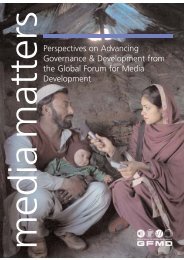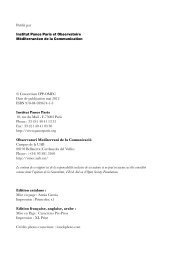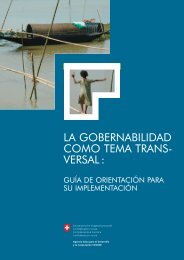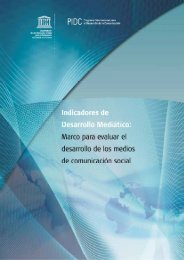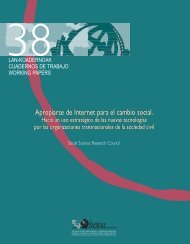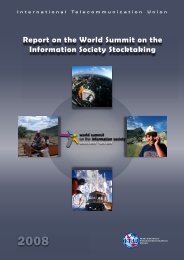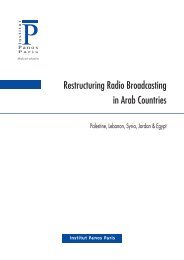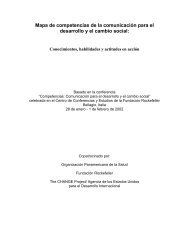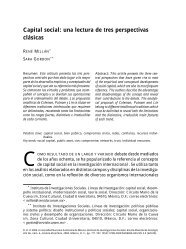Arab Knowledge Report 2009
Arab Knowledge Report 2009
Arab Knowledge Report 2009
- No tags were found...
Create successful ePaper yourself
Turn your PDF publications into a flip-book with our unique Google optimized e-Paper software.
knowledge over recent years. This willpermit us to detail, and closely scrutinise,the various manifestations and foundationsof knowledge in the <strong>Arab</strong> region.<strong>Arab</strong> states have, over the last quartercentury, witnessed marked progress on theindicator set relating to the proliferation ofknowledge among their citizens, startingwith the drop in illiteracy rates and endingwith the numbers of people holding higheruniversity degrees. When we considerthe three key indicators for educationused by the World Bank to measure astate’s readiness for involvement in theknowledge society–that is, adult 14 literacyrates, enrolment in secondary education,and enrolment in higher education–theprogress is demonstrable. In 1980, theaverage adult literacy rate in the <strong>Arab</strong>countries had reached approximately 55per cent for males and 25 per cent forfemales. In 2005, this average had reached82 per cent for males and 62 per cent forfemales. 15 The median of gross enrolmentratio in all programmes of secondaryeducation had reached, in 1980, 57 percent for males and 38 per cent for females,whereas in 2006 it reached 70 per cent formales and 65 per cent for females. 16 In1980, gross enrolment in tertiary educationexceeded 25 per cent for males and 20 percent for females in Lebanon only (41 and21 per cent respectively), while the medianreached 8 per cent for males and 4.6 percent for females. Tertiary education wasabsent or virtually absent in one-thirdof <strong>Arab</strong> countries (with gross enrolmentratio of less than 5 per cent). However by2005, only three <strong>Arab</strong> states were left withenrolment rates of less than 5 per cent,while the median had reached 18 per centfor men and 29 per cent for women. 17These achievements should not deflectour gaze from the failures that are causingmany <strong>Arab</strong> states to fail to bridge theknowledge gaps. Despite the <strong>Arab</strong> regionhaving spent 5 per cent of GDP and20 per cent of government budgets oneducation over the past forty years (Leagueof <strong>Arab</strong> States and UNDP, 2008), many ofthe structural aspects of weakness remainin place. Many key problems still form amajor obstacle to the establishment ofthe knowledge society, perhaps the mostprominent among them being continuingilliteracy. Around one third of the adultpopulation is unable to read and write,meaning that there are still some 60 millionilliterate people in the <strong>Arab</strong> countries,two-thirds of them women, and almost9 million children of elementary-schoolage outside school, most of them in thecountries that have not solved the illiteracyproblem. 18 It is impossible to realise theambition of setting up the knowledgeeconomy and society as long as theregional gross enrolment ratio in uppersecondary education remains below 55per cent for males and females alike, whenthe industrially advanced states and thoseof Central Asia have achieved enrolmentrates around 84 per cent. 19In addition to this quantitative shortfallin the dissemination of education, theregion suffers from numerous qualitativeproblems. In terms of qualitativeperformance, studies from 2003 makeclear that students from <strong>Arab</strong> countriesscore much lower than world averages ingrade-8 international tests in the sciencesand mathematics. The average scores inmathematics and science in the <strong>Arab</strong> regionwere 393 and 419, while the world averageswere 467 and 474 respectively (UNDP,2007a, in <strong>Arab</strong>ic). Similar internationalstudies undertaken in 2007 show that thelow performance of pupils from <strong>Arab</strong>countries in mathematics and the sciencescontinues; in 2007, the performanceof <strong>Arab</strong> pupils did not exceed 388 inmathematics and 424 in the sciences, whileworld averages were 445 and 466 (UNDP,2007d, in <strong>Arab</strong>ic).Over and above this, it seems thatthe correlation between education andeconomic growth in the <strong>Arab</strong> world isweak. This may be due to a number ofreasons, such as lack of conformity ofeducation and training programmes interms of quality or quantity to pressingdevelopmental needs. The human assetsformed by education also have not beenIn terms ofqualitativeperformance,students from <strong>Arab</strong>countries scoremuch lower thanworld averages inthe sciences andmathematicsThe correlationbetween educationand economicgrowth in the <strong>Arab</strong>world is weakPREAMBLE21



